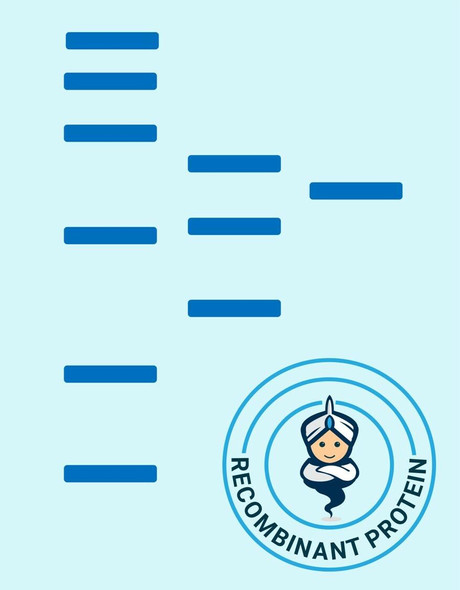Description
| Product Name: | Human UBQLN2 Recombinant Protein |
| Product Code: | RPPB5071 |
| Size: | 20µg |
| Species: | Human |
| Target: | UBQLN2 |
| Synonyms: | UBQLN2,Ubiquilin 2, CHAP1, PLIC2, Protein Linking IAP With Cytoskeleton 2,Ubiquitin-Like Product Chap1/Dsk2, ALS15, N4BP4, NEDD4 Binding Protein 4,Nedd4 Binding Protein 4, DSK2 Homolog, Ubiquilin-2, HRIHFB2157, HPLIC-2,PLIC-2, DSK2. |
| Source: | Escherichia Coli |
| Physical Appearance: | Sterile Filtered colorless solution. |
| Formulation: | UBQLN2 protein solution (0.25mg/ml) containing PhosphateBuffered Saline (pH7.4), 20% glycerol and 1mM DTT. |
| Stability: | Store at 4°C if entire vial will be used within 2-4 weeks. Store, frozen at -20°C for longer periods of time. For long term storage it is recommended to add a carrier protein (0.1% HSA or BSA).Avoid multiple freeze-thaw cycles. |
| Purity: | Greaterthan 90.0% as determined by SDS-PAGE. |
| Amino Acid Sequence: | MGSSHHHHHH SSGLVPRGSH MGSMAENGES SGPPRPSRGPAAAQGSAAAP AEPKIIKVTV KTPKEKEEFA VPENSSVQQF KEAISKRFKS QTDQLVLIFA GKILKDQDTLIQHGIHDGLT VHLVIKSQNR PQGQSTQPSN AAGTNTTSAS TPRSNSTPIS TNSNPFGLGS LGGLAGLSSLGLSSTNFSEL QSQMQQQLMA SPEMMIQIME NPFVQSMLSN PDLMRQLIMA NPQMQQLIQR NPEISHLLNNPDIMRQTLEI ARNPAMMQEM MRNQDLALSN LESIPGGYNA LRRMYTDIQE PMLNAAQEQF GGNPFASVGSSSSSGEGTQP SRTENRDPLP NPWAPPPATQ SSATTSTTTS TGSGSGNSSS NATGNTVAAA NYVASIFSTPGMQSLLQQIT ENPQLIQNML SAPYMRSMMQ SLSQNPDLAA QMMLNSPLFT ANPQLQEQMR PQLPAFLQQMQNPDTLSAMS NPRAMQALMQ IQQGLQTLAT EAPGLIPSFT PGVGVGVLGT AIGPVGPVTP IGPIGPIVPFTPIGPIGPIG PTGPAAPPGS TGSGGPTGPT VSSAAPSETT SPTSESGPNQ QFIQQMVQAL AGANAPQLPNPEVRFQQQLE QLNAMGFLNR EANLQALIAT GGDINAAIER LLGSQPS |
Ubiquilin-2, also known as UBQLN2 contains an N-terminal ubiquitin-likedomain and a C-terminal ubiquitin-associated domain. UBQLN2 is physicallylinked with proteasomes as well as ubiquitin ligases, and therefore isconsidered to functionally connect the ubiquitination machinery to theproteasome in order to affect in vivo protein degradation. Furthermore, UBQLN2binds the ATPase domain of the Hsp70-like Stch protein. Among the diseases whichare associated with UBQLN2: Amyotrophic lateral sclerosis 15, with or withoutfrontotemporal dementia as well as Amyotrophic lateral sclerosis type 15.
UBQLN2 Human Recombinant produced in E.Coli is a single,non-glycosylated polypeptide chain containing 647 amino acids (1-624 a.a) andhaving a molecular mass of 68.1kDa. UBQLN2 is fused to a 23 amino acid His-tagat N-terminus & purified by proprietary chromatographic techniques.
| UniProt Protein Function: | UBQLN2: Increases the half-life of proteins destined to be degraded by the proteasome; may modulate proteasome-mediated protein degradation. Defects in UBQLN2 are the cause of amyotrophic lateral sclerosis type 15 with or without frontotemporal dementia (ALS15). A neurodegenerative disorder affecting upper motor neurons in the brain and lower motor neurons in the brain stem and spinal cord, resulting in fatal paralysis. Sensory abnormalities are absent. The pathologic hallmarks of the disease include pallor of the corticospinal tract due to loss of motor neurons, presence of ubiquitin-positive inclusions within surviving motor neurons, and deposition of pathologic aggregates. The etiology of amyotrophic lateral sclerosis is likely to be multifactorial, involving both genetic and environmental factors. The disease is inherited in 5-10% of the cases. Patients with ALS15 may develop frontotemporal dementia. |
| UniProt Protein Details: | Protein type:Ubiquitin conjugating system Chromosomal Location of Human Ortholog: Xp11.21 Cellular Component: cytoplasm; plasma membrane Molecular Function:protein binding Biological Process: ER-associated protein catabolic process; regulation of macroautophagy Disease: Amyotrophic Lateral Sclerosis 15, With Or Without Frontotemporal Dementia |
| NCBI Summary: | This gene encodes an ubiquitin-like protein (ubiquilin) that shares high degree of similarity with related products in yeast, rat and frog. Ubiquilins contain a N-terminal ubiquitin-like domain and a C-terminal ubiquitin-associated domain. They physically associate with both proteasomes and ubiquitin ligases; and thus, are thought to functionally link the ubiquitination machinery to the proteasome to affect in vivo protein degradation. This ubiquilin has also been shown to bind the ATPase domain of the Hsp70-like Stch protein. [provided by RefSeq, Oct 2009] |
| UniProt Code: | Q9UHD9 |
| NCBI GenInfo Identifier: | 124056593 |
| NCBI Gene ID: | 29978 |
| NCBI Accession: | Q9UHD9.2 |
| UniProt Secondary Accession: | Q9UHD9,O94798, Q5D027, Q9H3W6, Q9HAZ4, |
| UniProt Related Accession: | Q9UHD9 |
| Molecular Weight: | 65,696 Da |
| NCBI Full Name: | Ubiquilin-2 |
| NCBI Synonym Full Names: | ubiquilin 2 |
| NCBI Official Symbol: | UBQLN2�� |
| NCBI Official Synonym Symbols: | DSK2; ALS15; CHAP1; N4BP4; PLIC2; HRIHFB2157�� |
| NCBI Protein Information: | ubiquilin-2 |
| UniProt Protein Name: | Ubiquilin-2 |
| UniProt Synonym Protein Names: | Chap1; DSK2 homolog; Protein linking IAP with cytoskeleton 2; PLIC-2; hPLIC-2; Ubiquitin-like product Chap1/Dsk2 |
| Protein Family: | Ubiquilin |
| UniProt Gene Name: | UBQLN2�� |
| UniProt Entry Name: | UBQL2_HUMAN |






